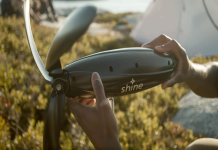World’s smallest bot takes flight.
Insect-sized robots have long held promise in the minds of sci-fi nerds.
They could poke through treacherous rubble in search-and-rescue missions, discreetly snoop on the guilty and innocent alike, and sometimes, just maybe, form into giant swarms that block out the sun and do the bidding of larger, less agile, robotic overlords.
“As far as we can tell, this is the world’s smallest flying robot,” Kevin Ma, a graduate student at Harvard’s Wyss Institute and a member of the robot team, told NBC News.
“It’s hard to argue that anything is more agile than a housefly — I think anyone who’s tried to swat one would agree,” said Rob Wood of the Wyss Institute at Harvard, and the lead researcher on the project. “This is the first controlled flight of an insect-scaled robot.”
Two mechanical muscles on the robots control the flapping and twisting motion of the wings. Previous versions of this robot would crash soon after they took off, but the most recent model has motion capture sensors and guiding algorithms that corrects its movements as it takes off.
In its current form, it’s mostly suited to help physicists and biologists study the dynamics of motion in a controlled environment. Woods estimates we’re still about 30 years away from being able to pack in the power and sensors required for a truly environment-aware robo-bug.
“This proof of concept design … gives us hope that we can develop insect-scale flying robots some day,” Vijay Kumar, professor at University of Pennsylvania who has worked with swarms of tiny quadracopters, wrote to NBC News in an email.
While bug-sized robots working individually or in giant swarms could be helpful — to serve as surrogate bees in pollination efforts, or sniff out dangerous chemicals in the atmosphere — they’d also make stealthy snoopers. This makes them a favorite target of privacy activists who frequently bring up stealthy miniature bots in discussions about technology and privacy.
“Presumably at some point you could have one the size of a mosquito that has a battery that operates for weeks and you could have the mosquito following you around and not be aware of it,” Al Franken, D-Minn, said. “God help us if an adolescent boy gets hold of one of these.”
It’s not just adolescent boys who dream of robo-insects. Sci-fi movies are full of them. There are the spidery critters that chase Tom Cruise after his eyeball transplant in “Minority Report,” the wriggling “bug” that invades the belly button of Keanu Reeves in “The Matrix,” and the wire-tapped cockroach that gets smushed a moment too late, in the cheesy Bruce Willis favorite, “The Fifth Element.”
But battery power and sensors pose gigantic hurdles for a pea-sized robot. For one, “You have to build everything from scratch,” Wood says, as motors and actuators aren’t manufactured in their size. The engineering also gets complicated. “When you scale things down like that things flex differently and experience forces that the material reacts to differently,” said Rick Cory, a roboticist at Disney Research.
For now, the robotic fly is powered and guided by batteries and sensors that aren’t built into its body. Instead, they are tethered to control and power systems by fine copper wire. While Wood’s group is developing a sturdy body that’ll stay in the air, collaborators around the country are busy shrinking sensors. Still others are working on ways to network them for the day when they will interact as a swarm. “It’s roughly broken down into: body, brain and colony,” Wood says.
And they’re toiling towards the same goal. When the “brains” of the bot are small enough and powerful enough to be hoisted onto a tiny robot frame, Woods and his team hope to have a ready, steady, unswattable robo-fly on their hands.






